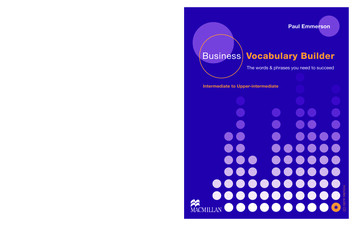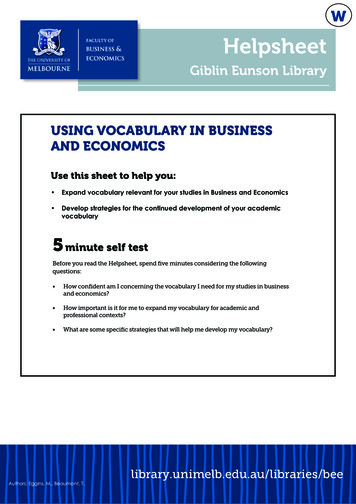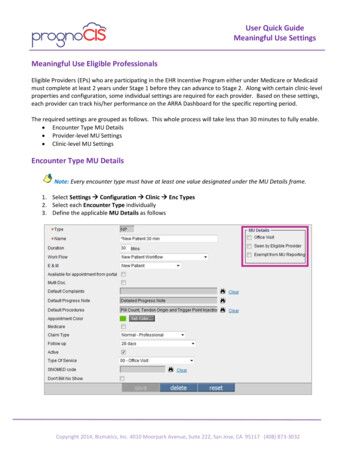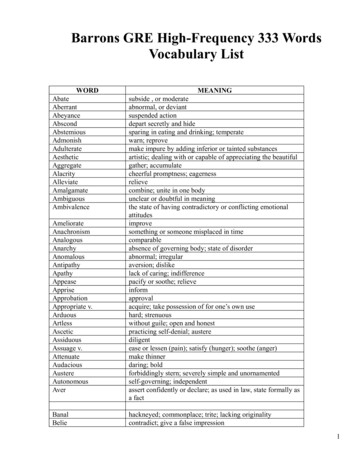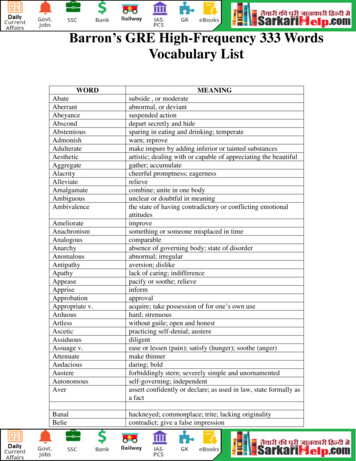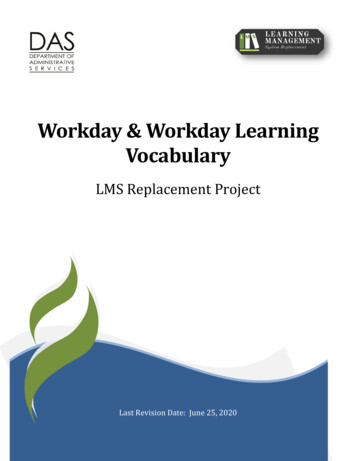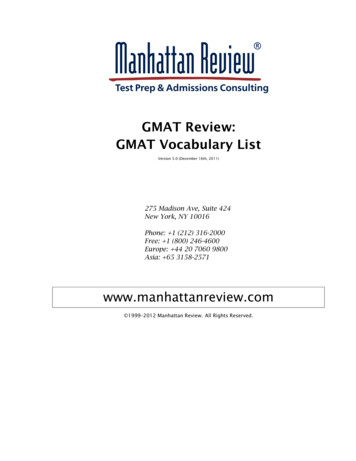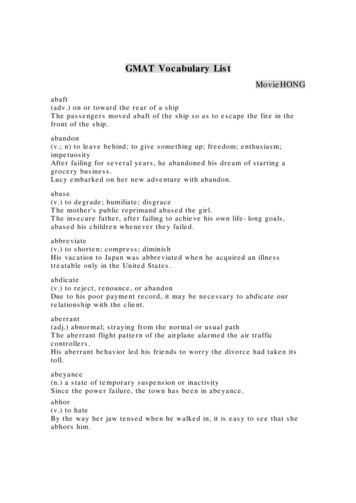
Transcription
PUBLISHED BY T H E PRESS SYNDICATE OF T H E UNIVERSITY O F C A M B R I D G EThe Pitt Building, Trumpington Street, Cambridge, United KingdomCAMBRIDGE UNIVERSITY PRESSThe Edinburgh Building, Cambridge CB2 2RU, UK40 West 20th Street, New York, NY 100114211, USA477 Williamstown Road, Port Melbourne, VIC 3207, AustraliaRuiz de Alarc6n 13, 28014 Madrid, SpainDock House, The Waterfront, Cape Town 8001, South AfricaO Cambridge University Press 2002This book is in copyright. Subject to statutory exceptionand to the provisions of relevant collective licensing agreements,no reproduction of any part may take place withoutthe written permission of Cambridge University Press.First published 2002Second printing 2002Third printing 2002Printed in Italy by G. Canale & C.Typeface Sabon 10113pt. System QuarkXPressB[GECKO LID]A catalogue record for this book is available from the British LibraryISBN 0 521 77529 9
ContentsINTRODUCTIONJOBS, PEOPLE ANDORGANIZATIONSm Problems at workA Health and safetyB Bullying and harassmentC DiscriminationManagers, executivesand directors0 Work and jobsA What do you do?B Word combinations with 'work'C Types of job and types of workWays o f workingA Old and new waysB Nice work if you can get itC Nature of workm Recruitment and selectionA RecruitmentB Applying for a jobC Selection proceduresm Skills and qualificationsA Education and trainingB Skilled and unskilledC The right personPay and benefitsA Wages, salary and benefitsB Compensation lC Compensation 2m People and workplacesA Employees and managementB Management and administrationC LabourD Personnel and human resources0 The career ladderA A job for lifeB A job for nowC In-house staff or freelancers?D Losing your jobA Managers and executives: UKB Managers and executives: USm Businesspeopleandbusiness leadersA Businesspeople and entrepreneursB Leaders and leadershipC Magnates, moguls and tycoonsm Organizations 1A Business and businessesB CommerceC EnterpriseD Word combinations with 'enterprise'm Organizations 2ABCDSelf-employed people andLimited liabilityMutualsNon-profit organizationsPRODUCTIONm Manufacturing and servicesA IndustryB Manufacturing and servicesC Countries and their industriesmThe development processA Market researchB Development and launchBusiness Vocabulary in Use
m Innovation and inventionA Innovation and inventionB Research and technologyC Patents and intellectual property(g Making thingsA ProductsB Mass productionC Capacity and outputm Materials and suppliersA InputsB Suppliers and outsourcingC Just-in-timem Business philosophiesA Total quality managementB Continuous improvementC BenchmarkingD Business process re-engineeringMARKETINGm theBuyers, sellers andmarketA Customers and clientsB Buyers and sellersC The marketD Word combinations with 'market'm Markets and competitorsA Companies and marketsB More word combinations with 'market'C Competitors and competitionm orientationMarketing and marketA MarketingB The four PSC Market orientation4Business Vocabulary in UseProducts and brandsA Word combinations with 'product'B GoodsC Brands and brandingaPriceA PricingB Word combinations with 'price'C Upmarket and downmarketD Mass markets and nichesm PlaceA Distribution: wholesalers, retailersand customersB ShopsC Direct marketingB PromotionA AdvertisingB The sales forceC Promotional activitiesm Thelnternet ande-commerceA The InternetB Clicks-and-mortarC B2B, B2C and B2GMONEYm Sales and costsA Sales lB Sales 2C CostsD Margins and mark-upsm unprofitabilityProfitability andA Profitable and unprofitable productsB Budgets and expenditureC Economies of scale and the learningcurve52
m Financial centresm Getting paidA Financial centresB Stock marketsC Other financial marketsD DerivativesA Shipping and billingB Trade creditC Accountsm Assets,liabilities and thebalance sheetm TradingA Market indexesB Market activity: good timesC . and bad timesA AssetsB DepreciationC LiabilitiesD Balance sheetam The bottom linem Share capital and debtEE) Indicators 2A CapitalB Share capitalC Loan capitalD SecurityE LeverageA Going upB Going downC Peaks and troughsD Boom and bustm Success and failureDOING THE RIGHT THINGA Cash mountains and surplusesB Debt and debt problemsC Turnarounds and bailoutsD BankruptcyWrongdoing and corruption88A WrongdoingB Bribery and corruptionC Fraud and embezzlementm Mergers,takeovers andsel l-offsm EthicsA Stakes and joint venturesB Mergers and takeoversC ConglomeratesA Code of ethicsB Ethical standardsC Ethical investmentFINANCE AND THE ECONOMYA Traditional bankingB New ways of bankingC Personal investingIndicators 1A Finance and economicsB Inflation and unemploymentC TradeD Growth and GDPA AccountsB ResultsB Personal finance.PERSONAL SKILLS78m Time and time management92A Timeframes and schedulesB Projects and project managementC Time tipsBusiness Vocabulary in Use5
m Stressand stressmanagementA When work is stimulatingB When stimulation turns to stressC Downshiftingm Leadershipandmanagement stylesA LeadershipB Modern management stylesC EmpowermentCULTUREm Business across cultures 1A Cultures and cultureB Distance and familiaritym Business across cultures 2A NamesB Business cardsC Dressm Business across cultures 3A Entertainment and hospitalityB TimeC Cross-cultural communicationTELEPHONE, FAX AND EMAlLTelephoningl : phones and numbersA Telephones and beyondB Phone, call and ringC NumbersD Doing things over the phonem Telephoning2: getting throughA Phoning scenarioB Asking to speak to someone 1C Voicemail6Business Vocabulary in UseTelephoning 3: messagesA Asking to speak to someone 2B Giving and taking messagesC Spelling namesD Taking messages: checking informationmTelephoning4: arrangementsA Making arrangementsB Closing the conversationC Changing arrangementsaFaxesA Sending faxesB Fax layoutC Receiving faxesA EmailB Email expressionsC Email abbreviationsBUSINESS SKILLSm Meetings1: types ofmeetingA Word combinations with 'meeting'B Types of meetingC How was the meeting?m chairpersonMeetings 2: the role of theA Before the meetingB During the meetingC Follow-upMeetings 3: points of viewA Opening the meetingB Inviting people to speakC Making your point108
m andMeetings 4: agreementdisagreement122m Negotiations3: furtheringnegotiationsA Discussion without argument?B AgreeingA Win-winB ProbingC DisagreeingC Proposal and counter-proposalD Trade-offsm techniquesMeetings 5: discussion124m Negotiations 4: difficultiesA HedgingB Checking understanding, interrupting,A ConfrontationB Confrontational negotiating tacticsreferring backC Agreement, consensus or compromise?D ConcludingC Dealing with problemsm agreementNegotiations 5: reachingPresentations 1: preparationand introductionA Deadlock and mediatorsB Agreements and contractsC Checking the dealA Types of presentationB Dos and don'ts: preparationAnswer keyC Key phrases: introductionm Presentations 2: main partIndexA Dos and don'ts: timingB Dos and don'ts: voiceC Rapport with the audienceD Key phrases: main partm andPresentations 3: closingquestionsA Dos and don'ts: body languageB Visual aidsC Key phrases: closing and dealing withquestionsm andNegotiations 1 : situationsnegotiators132A Types of negotiationB Word combinations with 'negotiations'C Bargaining(g Negotiations 2: preparing134A Preparing to negotiateB Negotiating scenarioC Negotiating stylesBusiness Vocabulary in Use7
Who is this book for?Business Vocabulary in Use is designed to help intermediate and upper-intermediatelearners of business English improve their business vocabulary. It is for peoplestudying English before they start work and for those already working who needEnglish in their job.Apart from improving your business vocabulary, the book also helps you to developthe language needed for important business communication skills.You can use the book on your own for self-study, or with a teacher in the classroom,one-to-one or in groups.How is the book organised?The book has 66 two-page units.The first 46 of these units are thematic and look at the vocabulary of business areas suchas people, organisations, production, marketing, finance and business-related economics.The other 20 units focus on the language of skills you need in business, such as thosefor presentations, meetings, telephoning and negotiations.The left-hand page of each unit explains new words and expressions, and the righthand page allows you to check and develop your understanding of them and howthey are used through a series of exercises.There is cross-referencing between units to show connections between the same wordor similar words used in different contexts.There is an answer key at the back of the book. Most of the exercises have questionswith only one correct answer. But some of the exercises, including the Over to youactivities at the end of each section (see below), are designed for writing andlordiscussion about yourself and your own organisation.There is also an index. This lists all the new words and phrases introduced in thebook and gives the unit numbers where they appear. The index also tells you how thewords and expressions are pronounced.The left-hand pageThis page introduces new vocabulary and expressions for each thematic or skills area.The presentation is divided into a number of sections indicated by letters: A, B, C,etc, with simple, clear titles.As well as explanations of vocabulary, there is information about typical wordcombinations and the grammar associated with particular vocabulary, for examplethe verbs that are typically used with particular nouns.There are notes on mistakes to avoid, for example:IYoucan't say that someone is 'a responsible'.There are also notes about differences between British and American English.BrE: CV; AmE: rCsumC or resumeBusiness Vocabulary in Use
The right-hand pageThe exercises on the right-hand page give practice in using the new vocabulary andexpressions presented on the left-hand page. Sometimes the exercises concentrate onusing the words or expressions presented on the left-hand page in context. Otherexercises practise the grammatical forms of items from the left-hand page. Some unitscontain diagrams to complete, or crosswords.'Over to you' sectionsAn important feature of Business Vocabulary in Use is the Over to you section at theend of each unit. There are sometimes alternative Over to you sections, for learnerswho are in work and those who are not. The Over to you sections give you thechance to put into practice the words and expressions in the unit in relation to yourown professional situation, studies or opinions.Self-study learners can do this section as a written activity.In the classroom, the Over to you sections can be used as the basis for discussionwith the whole class, or in small groups with a spokesperson for each groupsummarising the discussion and its outcome for the class. The teacher can then getstudents to look again at the exercises relating to points that have caused difficulty.Students can follow up by using the Over to you section as a written activity, forexample as homework.How to use the book for self-studyFind the topic you are looking by referring to the contents page or the index. Readthrough the explanations on the left-hand page of the unit. Do the exercises on theright-hand page. Check your answers in the key. If you have made some mistakes, goback and look at the explanations and exercise again. Note down important wordsand expressions in your notebook.How to use the book in the classroomTeachers can choose units that relate to students' particular needs and interests, forexample areas they have covered in course books, or that have come up in otheractivities. Alternatively, lessons can contain a regular vocabulary slot, where studentslook systematically at the vocabulary of particular thematic or skills areas.Students can work on the units in pairs, with the teacher going round the classassisting and advising. Teachers should get students to think about the logicalprocess of the exercises, pointing out why one answer is possible and others are not.We hope you enjoy using this book.Business Vocabulary in Use
Work and jobsWhat do you do?To find out what someone's job is you say 'What do you do?' Here, Kerstin talks about her job:'I work for a large European car maker. I work on car design. In fact, I run the designdepartment and I manage a team of designers: 20 people work under me. It's very interesting.One of my main responsibilities is to make sure that new model designs are finished on time.I'm also in charge of design budgets.I deal with a lot of different people in the company. I'm responsible for co-ordination betweendesign and production: I work with managers at our manufacturing plants.'!You can't say W.Word combinations with 'work'If you work or have work, you have a job. But you don't say that someone has d .Work is also the place where you do your job.Here are some phrases with 'work':/II!mHi. I'm Frank. I work in a bank in NewYork City. I leave for work at 7.30 everymorning.II go to work by train and subway.m I get to / arrive at work at about nine.II'm usually at work till six.r Luckily, I don't get ill very much so I'm notoften off work.You don't say, for example,or\IThe economy is growing fastand more people are in workthan ever before. The percentage, of people out of work has fallento its lowest level for 30 years.v.Types of job and types of workA full-time job is for the whole of the normal working week; a part-time jobis for less time than that.You say that someone works full-time or part-time.A permanent job does not finish after a fixed period; a temporary job finishes after a fixed period.You talk about temporary work and permanent work.10Business Vocabulary in Use
1, lPierre is talking about his work. Correct what he says.I work for a French supermarket company. (1)I work about the development of newsupermarkets. (2) In fact, I running the development department and (3) I am manage for ateam looking at the possi
Business Vocabulary in Use is designed to help intermediate and upper-intermediate learners of business English improve their business vocabulary. It is for people studying English before they start work and for those already working who need English in their job. Apart from improving your business vocabulary, the book also helps you to develop
